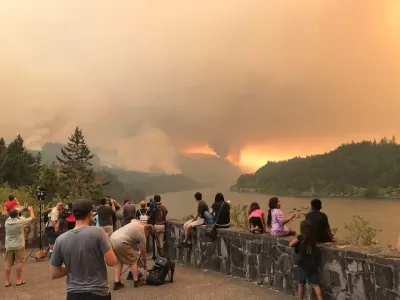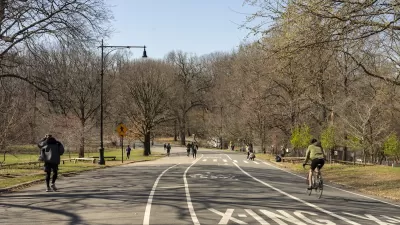Two new books chronicle the origin of U.S. policy on wildfire, the damage that policy has done, and why it’s unlikely to change any time soon.

In The New York Times, Brendan Koerner reviews two recently released nonfiction books that chronicle the markedly increased number of wildfires in the U.S., the causes of that increase, and the way that the current policy of the federal Fire Service is interfering with the natural ecology of fire-prone areas.
Koerner traces that policy to a fire known as the Big Blowup, which enveloped parts of Idaho in 1910. Seventy-eight firefighters died; Koerner writes, “Staggered by the scale of the destruction and the vitriol of the resulting newspaper headlines, the five-year-old United States Forest Service felt compelled to declare an all-out war on wildfires.”
The unintended consequences of the war of wildfires have been bigger, more intense fires, and higher costs of fighting them.
“[L]ike many well-intentioned policies that arise in the wake of tragedy, the war on wildfires has proved to be self-defeating. As detailed in Michael Kodas’s bracing 'Megafire' and Edward Struzik’s drier 'Firestorm,' today’s forests are often clogged with desiccated vegetation because—unlike in countless millenniums past—they are seldom cleansed by naturally occurring blazes. With such an abundance of fuel to feast on, wildfires like those currently raging in California have become increasingly ruinous and intense. Ten million acres of the United States burned in 2015, over three times more than the annual average throughout the 1970s. And the Forest Service now spends more than half its budget fighting fires, compared with just 16 percent in 1995.”
Neither author is the first to bring up the counter-productivity of wildfire policy in the U.S. in the last century, but the issue persists because possibly the most significant contributor (another being climate change) to the increased damage caused by wildfire is the millions of people settling on land at risk of burning.
And changing the policy—by allowing some fires to burn, and initiating controlled burns to clear out the brush that ultimately becomes fuel for uncontrolled fires—is both counterintuitive to many and wildly unpopular with those that live adjacent to those burns.
“There is no easy way,” Koerner writes, “to convince the owners of those homes that a fire they can glimpse from their bedrooms should be allowed to burn for long-term strategic purposes.”
Damage caused by these fires reaches well beyond the homes they consume; they also release greenhouse gasses that perpetuate climate change and burn hazardous substances leftover from mining operations across the West, according to the books reviewed.
"Megafire," at least, ends with optimism, but Koerner finds it “unintentionally” downbeat.
“[Kodas] expresses hope that these deaths will begin to awaken people to the fact that, ever since the Big Blowup, wildfire policy has been guided by a 'tangled tree of legends' rather than solid science. But that sentiment struck me as depressingly naïve. In recent years, high-profile tragedies have rarely transformed public discourse; instead, they’ve tended to inspire people to cling ever more fervently to their customary beliefs, as if it would be dishonorable to admit the existence of complexity and nuance. Such is life in the era of the knee-jerk double down, which is why the era of megafires is likely here to stay.”
FULL STORY: Are the American West’s Wildfires Inevitable?

Planetizen Federal Action Tracker
A weekly monitor of how Trump’s orders and actions are impacting planners and planning in America.

Restaurant Patios Were a Pandemic Win — Why Were They so Hard to Keep?
Social distancing requirements and changes in travel patterns prompted cities to pilot new uses for street and sidewalk space. Then it got complicated.

Maui's Vacation Rental Debate Turns Ugly
Verbal attacks, misinformation campaigns and fistfights plague a high-stakes debate to convert thousands of vacation rentals into long-term housing.

In California Battle of Housing vs. Environment, Housing Just Won
A new state law significantly limits the power of CEQA, an environmental review law that served as a powerful tool for blocking new development.

Boulder Eliminates Parking Minimums Citywide
Officials estimate the cost of building a single underground parking space at up to $100,000.

Orange County, Florida Adopts Largest US “Sprawl Repair” Code
The ‘Orange Code’ seeks to rectify decades of sprawl-inducing, car-oriented development.
Urban Design for Planners 1: Software Tools
This six-course series explores essential urban design concepts using open source software and equips planners with the tools they need to participate fully in the urban design process.
Planning for Universal Design
Learn the tools for implementing Universal Design in planning regulations.
Heyer Gruel & Associates PA
JM Goldson LLC
Custer County Colorado
City of Camden Redevelopment Agency
City of Astoria
Transportation Research & Education Center (TREC) at Portland State University
Camden Redevelopment Agency
City of Claremont
Municipality of Princeton (NJ)





























